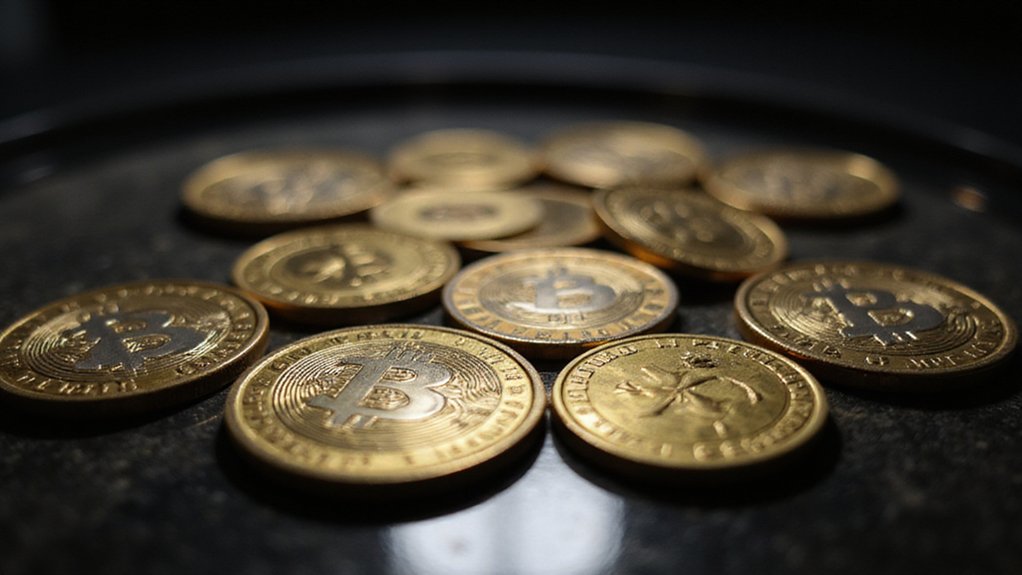International laws create a regulatory patchwork that transforms cryptocurrency oversight into an elaborate game of jurisdictional hopscotch. Organizations like IOSCO establish global recommendations while regional frameworks like the EU’s MiCA regulation attempt standardization, yet enforcement remains fragmented across borders. The decentralized nature of digital assets renders traditional sovereign monetary controls somewhat quaint—Bitcoin transfers don’t pause at customs checkpoints for inspection. This jurisdictional maze forces regulators into unprecedented cooperation, though the deeper complexities reveal fascinating contradictions.

While traditional currencies have spent centuries developing within the confines of sovereign borders—complete with central banks, regulatory oversight, and the occasional monarch’s portrait—cryptocurrencies arrived on the scene with the audacious notion that digital assets could operate seamlessly across jurisdictions without asking anyone’s permission.
This decentralized ambition has created what regulatory scholars might diplomatically call “challenges,” though “bureaucratic nightmares” might be more accurate.
The cross-border nature of cryptocurrency transactions exposes the fundamental inadequacy of purely national regulatory approaches.
When a Bitcoin transfer can traverse multiple jurisdictions faster than regulators can spell “blockchain,” the traditional model of sovereign financial oversight begins to resemble a game of regulatory whack-a-mole.
The speed of digital transactions has transformed financial regulation from methodical oversight into an increasingly frantic chase across jurisdictional boundaries.
Money laundering operations, previously constrained by geographic limitations and banking intermediaries, now exploit regulatory arbitrage with concerning efficiency.
International bodies have responded with varying degrees of urgency and coordination.
The International Organization of Securities Commissions established eighteen recommendations for crypto regulation, while the European Union’s Markets in Crypto-Assets regulation attempts regional standardization—an ambitious undertaking given the EU’s track record with achieving consensus on less controversial matters.
The World Economic Forum advocates for consistent global rules, though one might wonder whether an organization famous for annual gatherings in Swiss ski resorts fully grasps the street-level implications of crypto regulation.
These efforts face the inevitable tension between national sovereignty and international cooperation.
Different jurisdictions classify cryptocurrencies as currencies, commodities, or securities (sometimes simultaneously, creating delightful legal paradoxes), while tax treatment varies wildly across borders.
National regulators struggle to enforce domestic laws against international platforms that can relocate operations with relative ease.
The regulatory evolution reflects this complexity, beginning with anti-money laundering focus before expanding to investor protection and market integrity.
Core components now include KYC procedures, consumer protection frameworks, and licensing requirements for exchanges—though implementation remains frustratingly inconsistent.
Effective regulatory frameworks must establish transparency and accountability mechanisms that allow cryptocurrency investors to maintain trust in these emerging digital markets.
Notable regulatory milestones have emerged despite this fragmented landscape, including the approval of the first Bitcoin Spot ETFs in January 2024, signaling institutional acceptance within traditional financial markets. The Basel Committee has developed specialized frameworks addressing banks’ exposure to crypto assets, recognizing the growing intersection between traditional banking and digital currencies.
The challenge moving forward involves balancing innovation with risk management across multiple legal systems.
Clear, harmonized regulation could enhance market stability and investor confidence, while overly restrictive approaches risk stifling technological advancement.
The ultimate success of international cryptocurrency regulation may depend less on regulatory brilliance than on bureaucratic humility—acknowledging that twenty-first-century financial innovation cannot be governed entirely by twentieth-century regulatory frameworks.
Frequently Asked Questions
Which Countries Have Completely Banned Cryptocurrency Trading and Ownership?
Several nations have implemented complete cryptocurrency bans, though enforcement varies considerably.
China maintains the most extensive prohibition, banning both trading and mining while paradoxically developing its own digital yuan.
Afghanistan banned crypto under Taliban rule, Bangladesh prohibited all activities in 2017, and Egypt maintains strict restrictions.
Nepal joined this exclusive club in 2021, citing fraud concerns—though one wonders how effective these bans prove against determined traders operating through VPNs and decentralized exchanges.
How Do International Money Laundering Laws Affect Crypto Exchange Operations?
International money laundering laws fundamentally reshape crypto exchange operations through mandatory customer information sharing under FATF’s Travel Rule, requiring exchanges to track transactions above specified thresholds.
Compliance costs surge as platforms implement sophisticated monitoring systems, conduct risk assessments, and adapt to evolving AML requirements.
Exchanges must navigate the peculiar reality of maintaining blockchain’s pseudonymous nature while satisfying regulators’ demands for complete transparency—a contradiction that continues reshaping operational frameworks.
What Happens When Cryptocurrency Regulations Conflict Between Different Countries?
When cryptocurrency regulations clash between jurisdictions, businesses face operational nightmares—complying with conflicting legal requirements while users exploit regulatory arbitrage opportunities.
Companies often retreat to crypto-friendly havens, creating enforcement gaps that regulators despise.
Cross-border disputes become jurisdictional puzzles, with courts interpreting identical transactions differently.
This regulatory discord fragments markets, stifles innovation, and ironically undermines the very consumer protection these conflicting rules purport to provide.
Are There International Standards for Cryptocurrency Taxation Across Borders?
While over 150 jurisdictions have developed cryptocurrency tax guidance, no unified international framework exists—a regulatory patchwork that would make even seasoned tax attorneys weep.
The OECD’s Crypto-Asset Reporting Framework (CARF) represents the most ambitious harmonization effort, with 40+ countries committing to implementation by 2027.
This standard mandates automatic information exchange between nations, requiring crypto platforms to report transaction data—though enforcement across decentralized finance remains, shall we say, optimistically challenging.
How Do Sanctions Impact Cross-Border Cryptocurrency Transactions and Compliance?
Sanctions create a regulatory cat-and-mouse game where sanctioned entities increasingly leverage cryptocurrency’s pseudonymous nature to circumvent traditional banking restrictions.
With $15.8 billion flowing to sanctioned jurisdictions in 2024, compliance becomes extraordinarily complex—requiring sophisticated blockchain analytics and cross-jurisdictional cooperation.
OFAC now designates specific cryptocurrency addresses, while centralized exchanges face mounting pressure to implement robust screening protocols, transforming digital assets from regulatory blind spots into heavily monitored financial instruments.









